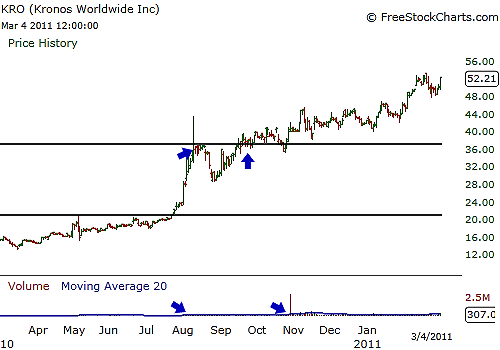
HOT TOPICS LIST
- MACD
- Fibonacci
- RSI
- Gann
- ADXR
- Stochastics
- Volume
- Triangles
- Futures
- Cycles
- Volatility
- ZIGZAG
- MESA
- Retracement
- Aroon
INDICATORS LIST
LIST OF TOPICS
PRINT THIS ARTICLE
by Billy Williams
If you want to profit big in the market, then make sure that you are trading along with the major players.
Position: Hold
Billy Williams
Billy Williams has been trading the markets for 27 years, specializing in momentum trading with stocks and options.
PRINT THIS ARTICLE
VOLUME
Trading With The Major Players
03/08/11 11:59:37 AMby Billy Williams
If you want to profit big in the market, then make sure that you are trading along with the major players.
Position: Hold
| Momentum trading is fueled by trading volume; the more volume, the greater the amount of liquidity in a given stock, which makes it easier to get in and out of a trade. More important, rising volume shows an increased level of interest in a stock and it also reveals something of major significance at a seminal level -- the participation of major institutional traders. Retail trading makes up only a small portion of the market's daily trading volume, but major institutional traders such as hedge funds, pension funds, mutual funds, and so forth make up the lion's share of this trading volume. Since they are the bulk of daily trading volume, it stands to reason that their participation has a lot to do with who controls a given stock and is the major influence on its trend. See Figure 1. |

|
| FIGURE 1: KRO. In late July and November 2010, trading volume started rise from 4,000 average shares traded to over almost 200,000 average shares trading daily, taking price higher each time. |
| Graphic provided by: www.freestockcharts.com. |
| |
| If you learn how to spot rising trade volume in a given stock, you can begin to understand when major institutions are taking a position in a stock and then enter with the confidence that you are trading on the side of the major players. Institutions do not buy into a position the way retail traders do and they typically buy a position somewhat piecemeal in uneven lots, such as 18,753 shares here and 25,301 shares there. The reason they do this is to avoid attracting the attention of other institutional traders as well as the floor traders on the stock exchanges. They do this to prevent the price of the stock being bid higher as traders on the sidelines look to take advantage of the buying momentum. This would make it more expensive for a given institution that hopes to gain the lowest price possible and why they want to spread their buying out over uneven lots and over a given time period. |
| While buying shares in this manner does help institutions avoid having their positions being detected in the beginning, a skilled trader who is familiar with their tactics can begin to watch for rising averages in a stock's trading volume. By placing volume levels on a chart and then overlaying a 20-day simple moving average (SMA) on volume, you can begin to spot when trade volume starts to rise. This indicates that a stock is gaining the following of major players and institutional support. This creates a domino effect as a stock trades on thin volume in the beginning of its trade cycle, which also creates bigger spreads between the bid price and the ask price. Later, as a company matures and begins to report improved earnings, larger players in the investment community may start staking out positions in the company, causing the stock to rise, liquidity to improve, and more competitive pricing between the bid and ask, which attracts even more investors. In the final phase of the cycle, both the major player and the retail market begin to flood into the stock, which spikes volume levels but also drives the upward momentum of the stock. |
| It's important to understand how this cycle plays out over and over again because you can then use a combination of price action and technical skills to enter the move just as volume begins to drive price higher, making sure that you're trading on the same side as the major forces that drive the market. |
Billy Williams has been trading the markets for 27 years, specializing in momentum trading with stocks and options.
| Company: | StockOptionSystem.com |
| E-mail address: | stockoptionsystem.com@gmail.com |
Traders' Resource Links | |
| StockOptionSystem.com has not added any product or service information to TRADERS' RESOURCE. | |
Click here for more information about our publications!
Comments
Date: 03/15/11Rank: 4Comment:

|

Request Information From Our Sponsors
- VectorVest, Inc.
- Executive Premier Workshop
- One-Day Options Course
- OptionsPro
- Retirement Income Workshop
- Sure-Fire Trading Systems (VectorVest, Inc.)
- Trading as a Business Workshop
- VectorVest 7 EOD
- VectorVest 7 RealTime/IntraDay
- VectorVest AutoTester
- VectorVest Educational Services
- VectorVest OnLine
- VectorVest Options Analyzer
- VectorVest ProGraphics v6.0
- VectorVest ProTrader 7
- VectorVest RealTime Derby Tool
- VectorVest Simulator
- VectorVest Variator
- VectorVest Watchdog
- StockCharts.com, Inc.
- Candle Patterns
- Candlestick Charting Explained
- Intermarket Technical Analysis
- John Murphy on Chart Analysis
- John Murphy's Chart Pattern Recognition
- John Murphy's Market Message
- MurphyExplainsMarketAnalysis-Intermarket Analysis
- MurphyExplainsMarketAnalysis-Visual Analysis
- StockCharts.com
- Technical Analysis of the Financial Markets
- The Visual Investor
